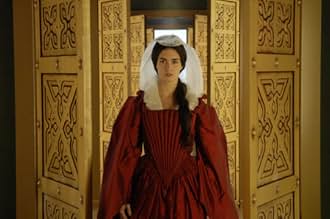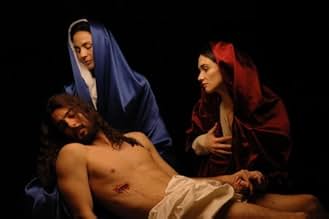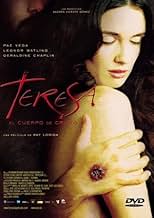अपनी भाषा में प्लॉट जोड़ेंA drama based on the life of Spain's feminist mystic Saint Teresa (Vega).A drama based on the life of Spain's feminist mystic Saint Teresa (Vega).A drama based on the life of Spain's feminist mystic Saint Teresa (Vega).
- पुरस्कार
- 1 जीत और कुल 1 नामांकन
फ़ोटो
कहानी
क्या आपको पता है
- ट्रिवियाKarola Sánchez's debut.
- कनेक्शनReferenced in ¿Qué fue de Jorge Sanz?: Edad Media (2010)
फीचर्ड रिव्यू
Perfectionist work, useless in the thoughts behind.
This one has some interesting elements, from some points of view, despite its (various) flaws. Whoever produced it knew the effect that Paz Vega can have, and places her here with her character of "Lucía y el Sexo" in mind (so, in this sense, this film could only have her in the title role). As Lucía, she was (along with the sexual tension she also helped creating) one of the main agents in the generation of the whole film in the mind of the writer. A somehow satellite character, though essential to the plot. Here, she is brought to the center of that plot, the same sexual tensions are kept, and what is generated is the evolution of her inner fight and the way the world outside Teresa watches those evolutions. That world also includes us, viewers, who put our own (eventually not)religious conceptions in judging her, just like the characters in the film. Anyway, even some aspects of the cinematography reveal some references to Medem's film (some landscapes overexposed to light, dreamlike, ideas generator mood).
This is built through episodes, almost boards, biographical frescos. Biography facts are not interpreted, the inner fight is chosen. Alright with me, it's an option (rather contemporary in cinema). Also there is a great (to my view) religious conventionalism which, in spite, tries to strike you as something revolutionary and new. The "DaVinci Code" phenomena brought to a mainstream context the idea of "humanizing" religious characters, once untouched in their sacred biographies. The code did it with Christ (it was not new then, but than again, nobody knew it yet) and his supposed romantic involvement with Madalena. Here we get something flagrant, with assuming "possession" by the Christ as something with sexual connotations (Teresa playing Madalena in the Pietà shot is flagrant). But this is also OK, doesn't strike me as a new concept anymore, but it's an option.
What upsets me here is the subtle manipulation that is intended:we get an historical character who became, in her time, one of the most solid symbols of the counter-reformation (the film even refers to the support with which she was granted by the Jesuits, themselves one of the most powerful and efficient agents of reformation, especially in Iberia, founded by the Spanish Loyola). That character, until now looked as a milestone of sanctity, rigor and return to traditions then forgotten, is here transformed in a character of free thinking, revolutionary who, against everybody, would fight for freedoms never dreamed of (woman's emancipation...). What upsets me is not the reinterpretation, but the incoherence with which she is placed in that specific world. Anyway, interesting to verify how each moment in time rewrites History before introducing it, completely crystallized, in the heads of that moments generations.
What also occurred to me while i was watching this in a cinema room crowded with 8 people was how abstract was the medieval thinking (officialy this is post middle ages, but minds take time to follow). Anyway, death was decided based on the interpretation of completely abstract, non physical beliefs. Art was conquered since then by abstract thinking, but the common minds have evolved to become more and more in need of concrete objects to be guided.
The other very interesting element has to do with cloth. One of this days i was reading a "I need to know" IMDb thread, and Mr. Ted Goranson asked for help to find films that use cloth as a cinematic element. Well this should be quite interesting for that matter. The story and Teresa's mental evolution and state of mind are told with great precision by the evolution of her cloth (i bare in mind the vivid red she wears as Madalena by Christ, the baroque initial dress and the texture of her final cloth).
Than other not so important incoherences (films are practically all filled with them) such as filming the episodes of the life of a Spanish religious symbol in XVI century using a Portuguese monastery of several dates (including XVII century). This monastery is the spiritual core of temple knights Portuguese (strong) tradition, the one which was once rejected by the same kind of church thinking against which this reinterpreted Teresa fights. Coincidence? probably yes.
The cinematography has a refined baroque quality, always pointing out through light and shadow the most important composition points. This is well crafted (as the overall production), i always remember the face side line always worked as a light line against a dark second plan. Gorgeous.
My evaluation: 3/5 worth watching for elements referred, though not so well paced
http://www.7eyes.wordpress.com
This one has some interesting elements, from some points of view, despite its (various) flaws. Whoever produced it knew the effect that Paz Vega can have, and places her here with her character of "Lucía y el Sexo" in mind (so, in this sense, this film could only have her in the title role). As Lucía, she was (along with the sexual tension she also helped creating) one of the main agents in the generation of the whole film in the mind of the writer. A somehow satellite character, though essential to the plot. Here, she is brought to the center of that plot, the same sexual tensions are kept, and what is generated is the evolution of her inner fight and the way the world outside Teresa watches those evolutions. That world also includes us, viewers, who put our own (eventually not)religious conceptions in judging her, just like the characters in the film. Anyway, even some aspects of the cinematography reveal some references to Medem's film (some landscapes overexposed to light, dreamlike, ideas generator mood).
This is built through episodes, almost boards, biographical frescos. Biography facts are not interpreted, the inner fight is chosen. Alright with me, it's an option (rather contemporary in cinema). Also there is a great (to my view) religious conventionalism which, in spite, tries to strike you as something revolutionary and new. The "DaVinci Code" phenomena brought to a mainstream context the idea of "humanizing" religious characters, once untouched in their sacred biographies. The code did it with Christ (it was not new then, but than again, nobody knew it yet) and his supposed romantic involvement with Madalena. Here we get something flagrant, with assuming "possession" by the Christ as something with sexual connotations (Teresa playing Madalena in the Pietà shot is flagrant). But this is also OK, doesn't strike me as a new concept anymore, but it's an option.
What upsets me here is the subtle manipulation that is intended:we get an historical character who became, in her time, one of the most solid symbols of the counter-reformation (the film even refers to the support with which she was granted by the Jesuits, themselves one of the most powerful and efficient agents of reformation, especially in Iberia, founded by the Spanish Loyola). That character, until now looked as a milestone of sanctity, rigor and return to traditions then forgotten, is here transformed in a character of free thinking, revolutionary who, against everybody, would fight for freedoms never dreamed of (woman's emancipation...). What upsets me is not the reinterpretation, but the incoherence with which she is placed in that specific world. Anyway, interesting to verify how each moment in time rewrites History before introducing it, completely crystallized, in the heads of that moments generations.
What also occurred to me while i was watching this in a cinema room crowded with 8 people was how abstract was the medieval thinking (officialy this is post middle ages, but minds take time to follow). Anyway, death was decided based on the interpretation of completely abstract, non physical beliefs. Art was conquered since then by abstract thinking, but the common minds have evolved to become more and more in need of concrete objects to be guided.
The other very interesting element has to do with cloth. One of this days i was reading a "I need to know" IMDb thread, and Mr. Ted Goranson asked for help to find films that use cloth as a cinematic element. Well this should be quite interesting for that matter. The story and Teresa's mental evolution and state of mind are told with great precision by the evolution of her cloth (i bare in mind the vivid red she wears as Madalena by Christ, the baroque initial dress and the texture of her final cloth).
Than other not so important incoherences (films are practically all filled with them) such as filming the episodes of the life of a Spanish religious symbol in XVI century using a Portuguese monastery of several dates (including XVII century). This monastery is the spiritual core of temple knights Portuguese (strong) tradition, the one which was once rejected by the same kind of church thinking against which this reinterpreted Teresa fights. Coincidence? probably yes.
The cinematography has a refined baroque quality, always pointing out through light and shadow the most important composition points. This is well crafted (as the overall production), i always remember the face side line always worked as a light line against a dark second plan. Gorgeous.
My evaluation: 3/5 worth watching for elements referred, though not so well paced
http://www.7eyes.wordpress.com
टॉप पसंद
रेटिंग देने के लिए साइन-इन करें और वैयक्तिकृत सुझावों के लिए वॉचलिस्ट करें
विवरण
- रिलीज़ की तारीख़
- कंट्री ऑफ़ ओरिजिन
- आधिकारिक साइट
- भाषा
- इस रूप में भी जाना जाता है
- Theresa: The Body of Christ
- फ़िल्माने की जगहें
- उत्पादन कंपनियां
- IMDbPro पर और कंपनी क्रेडिट देखें
बॉक्स ऑफ़िस
- बजट
- $1,00,00,000(अनुमानित)
- दुनिया भर में सकल
- $8,98,401
- चलने की अवधि1 घंटा 37 मिनट
- रंग
- ध्वनि मिश्रण
इस पेज में योगदान दें
किसी बदलाव का सुझाव दें या अनुपलब्ध कॉन्टेंट जोड़ें

टॉप गैप
By what name was Teresa, el cuerpo de Cristo (2007) officially released in Canada in English?
जवाब

























